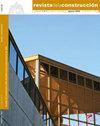含热原硅补强胶凝材料砂浆的性能研究
IF 1.4
4区 工程技术
引用次数: 0
摘要
研究了火山灰性质的粉煤灰(FA)、硅灰(SF)和磨碎的高炉矿渣(GGBFS)作为补充胶凝材料(SCMs)对添加了热原二氧化硅的水泥砂浆性能的影响。首先,使用CEM I 42.5 r型水泥制备标准参比(SR)样品。在水泥中加入热原二氧化硅(按重量计0.5%),制备另一组参考(PR)砂浆样品。用FA、SF和GGBFS代替PR砂浆中的水泥,分别达到10%、20%和30%。使用振动台将砂浆样品放置在40x40x160 mm的金属模具中。第二天,将样品从模具中取出,水固化7、28和90天。结果表明,延长养护时间有助于改善砂浆的力学性能。此外,PR砂浆的物理性能比SR砂浆受到更积极的影响。sf -取代砂浆的抗压强度最高,其次是GGBFS-和FA-取代砂浆。综上所述,热原二氧化硅对材料的早期强度有一定的贡献,随后又降低。本文章由计算机程序翻译,如有差异,请以英文原文为准。
Investigation of properties of mortar containing pyrogenic silica-added supplementary cementitious materials
This study investigated the effect of supplementary cementitious materials (SCMs) with pozzolanic nature fly-ash (FA), silica fume (SF), and ground granulated blast furnace slag (GGBFS) on the properties of cement mortar with pyrogenic silica addition. First, standard reference (SR) samples were prepared using CEM I 42.5 R-type cement. Pyrogenic silica was added to cement (0.5% by weight) to prepare another group of reference (PR) mortar samples. Cement in PR mortars was replaced with FA, SF, and GGBFS up to 10, 20, and 30%. The mortar samples were placed in 40x40x160 mm metal molds using a vibrating table. The following day the samples were removed from the molds and water cured for 7, 28, and 90 days. The results showed that increases in curing times helped improve the mechanical properties of the mortars. Moreover, the physical properties of PR mortars were affected more positively than the SR mortars. SF-substituted mortars had highest compressive strength, followed by GGBFS- and FA- substituted mortars. In conclusion, pyrogenic silica contributed to some extent to early strength, followed by a decrease.
求助全文
通过发布文献求助,成功后即可免费获取论文全文。
去求助
来源期刊

Revista de la Construccion
工程技术-工程:土木
CiteScore
2.30
自引率
21.40%
发文量
0
期刊介绍:
The Journal of Construction is aimed at professionals, constructors, academics, researchers, companies, architects, engineers, and anyone who wishes to expand and update their knowledge about construction. We therefore invite all researchers, academics, and professionals to send their contributions for assessment and possible publication in this journal. The publications are free of publication charges.
OBJECTIVES
The objectives of the Journal of Construction are:
1. To disseminate new knowledge in all areas related to construction (Building, Civil Works, Materials, Business, Education, etc.).
2. To provide professionals in the area with material for discussion to refresh and update their knowledge.
3. To disseminate new applied technologies in construction nationally and internationally.
4. To provide national and foreign academics with an internationally endorsed medium in which to share their knowledge and debate the topics raised.
 求助内容:
求助内容: 应助结果提醒方式:
应助结果提醒方式:


